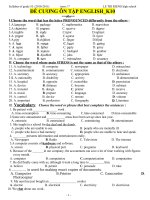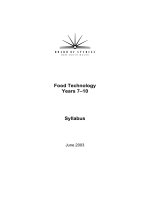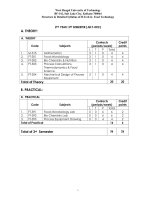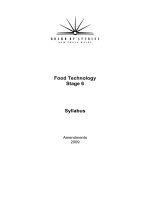Syllabus FUEL
Bạn đang xem bản rút gọn của tài liệu. Xem và tải ngay bản đầy đủ của tài liệu tại đây (486.34 KB, 46 trang )
Syllabus FUEL L-1
Fuels
Fuel is a combustible substance which during
combustion gives large amount of heat.
There are chemical fuels, nuclear fuels and fossil
fuels.
Classification of Fuels
These can be classified on the basis of their
occurrence and physical state
On the basis of occurrence they are of two types:
Primary Fuels: Fuels which occur in nature as such
are called primary fuels. E.g., wood, peat, coal,
petroleum, and natural gas.
Secondary Fuels: The fuels which are derived from
the primary fuels by further chemical processing are
called secondary fuels. E,g., coke, charcoal,
kerosene, coal gas, producer gas etc.
(ii) On the basis of physical state these may be
classified as:
Solid Fuels
Liquid Fuels
Gaseous Fuels
Calorific value: It is defined as the total quantity of
heat liberated when a unit mass of a fuel is burnt
completely.
Units of Calorific value:
System
Solid/Liquid Gaseous
Fuels
Fuels
CGS
MKS
B.T.U
Calories/gm
k cal/kg
BTU/lb
Calories/cm3
k cal/m3
BTU/ft3
The quantity of heat can be measured in the
following units:
(i) Calorie: It is defined as the amount of heat
required to raise the temperature of 1gm of water by
1oC
1 calorie = 4.184 Joules
(ii) Kilo Calorie: 1 k cal = 1000 cal
(iii) British thermal unit: (B. T. U.) It is defined as the
amount of heat required to raise the temperature of 1
pound of water through 1oF.
1 B.T.U. = 252 Cal = 0.252 k cal
(IV) Centigrade heat unit (C.H.U): It is defined as
the amount of heat required to raise the temperature
of 1 pound of water through 1oC.
1k cal = 3.968 B.T.U.
= 2.2 C.H.U.
Gross and net calorific Value
Gross Calorific Value: It is the total amount of heat
generated when a unit quantity of fuel is completely
burnt in oxygen and the products of combustion are
cooled down to the room temperature.
As the products of combustion are cooled down to
room temperature, the steam gets condensed into
water and latent heat is evolved. Thus in the
determination of gross calorific value, the latent heat
also gets included in the measured heat. Therefore,
gross calorific value is also called the higher calorific
value.
The calorific value which is determined by Bomb
calorimeter gives the higher calorific value (HCV)
Net Calorific Value: It is defined as the net heat
produced when a unit quantity of fuel is completely
burnt and the products of combustion are allowed to
escape.
The water vapour do not condense and escape with
hot combustion gases. Hence, lesser amount than
gross calorific value is available. It is also known as
lower calorific value (LCV).
LCV=HCV-Latent heat of water vapours formed
Since 1 part by weight of hydrogen gives nine parts
by weight of water i.e.
H + 1O → H O
2 2 2
2
Therefore,
LCV=HCV-weight of hydrogen x 9 x latent heat of
steam
= HCV-weight of hydrogen x 9 x 587
Determination of Calorific value
1. Determination of calorific value of solid and non
volatile liquid fuels: It is determined by bomb
calorimeter.
Principle: A known amount of the fuel is burnt in
excess of oxygen and heat liberated is transferred to
a known amount of water. The calorific value of the
fuel is then determined by applying the principle of
calorimetery i.e. Heat gained = Heat lost
Bomb Calorimeter
Calculations
Let weight of the fuel sample taken = x g
Weight of water in the calorimeter = W g
Water equivalent of the Calorimeter, stirrer, bomb,
thermometer = w g
Initial temperature of water = t1oC
Final temperature of water = t2oC
Higher or gross calorific value = C cal/g
Heat gained by water = W x ∆t x specific heat of water
= W (t2-t1) x 1 cal
Heat gained by Calorimeter = w (t2-t1) cal
Heat liberated by the fuel = x C cal
Heat liberated by the fuel = Heat gained by water and
calorimeter
x C = (W+w) (t2-t1) cal
C=(W+W)(t2-t1) cal/g
x
Net Calorific value:
Let percentage of hydrogen in the fuel = H
Weight of water produced from 1 gm of the fuel =
9H/100 gm
Heat liberated during condensation of steam
= 0.09H × 587 cal
Net (Lower calorific value) = GCV-Latent heat of
water formed
= C-0.09H × 587 cal/gm
Corrections: For accurate results the following
corrections are also incorporated:
(a)Fuse wire correction: As Mg wire is used for
ignition, the heat generated by burning of Mg wire
is also included in the gross calorific value. Hence
this amount of heat has to be subtracted from the
total value.
(b)Acid Correction: During combustion, sulphur and
nitrogen present in the fuel are oxidized to their
corresponding acids under high pressure and
temperature.
S + O → SO
2
2
= -144,000 Cal
2SO + O + 2H O → 2∆H
H SO
2 2
2
2 4
∆H
=
-57,160
Cal
2 N + 5O + 2H O → 4HNO
2
2
2
3
The corrections must be made for the heat liberated
in the bomb by the formation of H2SO4 and HNO3.
The amount of H2SO4 and HNO3 is analyzed by
washings of the calorimeter.
For each ml of 0.1 N H2SO4 formed, 3.6 calories
should be subtracted.
For each ml of 0.01 HNO3 formed, 1.43 calories must
be subtracted.
(C) Cooling correction: As the temperature rises
above the room temperature, the loss of heat does
occur due to radiation, and the highest temperature
recorded will be slightly less than that obtained. A
temperature correction is therefore necessary to get
the correct rise in temperature.
If the time taken for the water in the calorimeter to cool
down from the maximum temperature attained, to the
room temperature is x minutes and the rate of cooling
is dt/min, then the cooling correction = x × dt. This
should be added to the observed rise in temperature.
Therefore, Gross calorific value
C=(W+w)(t2-t1+Cooling correction)-[Acid+ fuse
corrections] / Mass of the fuel.
Theoretical calculation of Calorific value of a Fuel:
The calorific value of a fuel can be calculated if the
percentages of the constituent elements are known.
Substrate
Calorific value
Carbon
8080
Hydrogen
34500
Sulphur
2240
If oxygen is also present, it combines with hydrogen to
form H2O. Thus the hydrogen in the combined form is
not available for combustion and is called fixed
hydrogen.
Amount of hydrogen available for combustion = Total
mass of hydrogen-hydrogen combined with oxygen.
1g
1
H 2 + O2 → H 2O
2
8g
9g
Fixed Hydrogen = Mass of oxygen in the fuel
Therefore, mass of hydrogen available for combustion
= Total mass of hydrogen-1/8 mass of oxygen in fuel
=H-O/8
Dulong’s formula for calculating the calorific value is
given as:
Gross calorific Value (HCV)
1
O
=
[8080C + 34,500( H − ) + 2,240 S ]kcal / kg
100
8
Net Calorific value (LCV)
9H
= [ HCV −
× 587]kcal / kg
100
= [ HCV − 0.09 H × 587]kcal / kg
Characteristics of Good Fuel:
(i) Suitability: The fuel selected should be most suitable for
the process. E.g., coke made out of bituminous coal is
most suitable for blast furnace.
(ii) High Calorific value
(iii) Ignition Temperature: A good fuel should have moderate
ignition temperature.
(iv) Moisture content: Should be low
(v) Non combustible matter content
(vi) Velocity of combustion: It should be moderate
(vii) Nature of the products
(viii) Cost of fuel, (ix) Smoke, (x) Control of the process
FUEL
L-2
Solid Fuels: Primary as well as secondary are widely
used in domestic and industrial purposes.
e.g., wood, coal, charcoal and coke.
Wood: Wood has been used as a fuel from ancient
times. Due to large scale deforestation, wood is no
longer used except in forest areas where wood is
available at a low cost.
Wood when freshly cut contains 25-50% moisture.
Normally it is used in air dried condition with 10-15
percent moisture content.
The calorific value of air dried wood is about 35004500 kcal/kg.
When wood burns, the ash content is low but the
oxygen content is very high. This makes even dry
wood a fuel of low calorific value.
Wood charcoal is obtained by destructive distillation of
wood.
The major use of wood charcoal is for producing
activated carbon.
Coal: coal is regarded as a fossil fuel produced from
the vegetable debris under conditions of high
temperature and pressure over million of years.
The transformation of the vegetable debris to coal
takes place in two stages:
(a)Biochemical or peat stage: During this stage, the
plant materials were attacked by various micro
organisms.
(b)Chemical stage or metamorphism: In this stage,
the peat deposit buried under sedimentary deposits
lose moisture and volatile components under the
effect of high temperature and pressure.
The peat gets enriched in carbon whereas its oxygen
content decreases.
The spongy peat transforms into hard brittle coal
gradually. The time required for the formation of young
brown coal is of the order of 107 years.
Classification of Coal: Coals are mainly classified on
the basis of their degree of coalification from the
parent material, wood. When wood is converted into
coal, there is gradual increase in the concentration of
carbon and decrease in the percentage of oxygen and
nitrogen.
Coal is given a ranking depending upon the carbon
content of the coal from wood to anthracite.
Type of
coal
Percentage (dry, mineral matter
free basis)
C
H
O
N
20-40 0-0.5
%
Calorifi
moist c value
ure
VM
Wood
45-50 5-6
-
70-90
Peat
45-60 3.5-6.5 20-45 0.75-3 45-75 70-90
Brown Coal 60-75 4.5-5.5 17-35 0.75-2 45-60 30-50
Bituminous 75-90 4.0-5.5 20-30 0.75-2 11-50 10-20
coal
Anthracite
90-95 3-4
2-3
0.5-2
40004500
41255280
66007100
66008800
84703.8-10 1.5-3.5
8800









